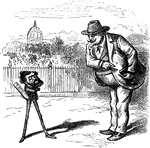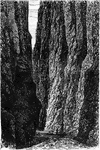
The Valley of Hell
The Höllental (Valley of Hell) is one of the routes on the German side leading up the Zugspitze (the…
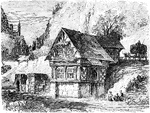
Peasant's House in the Black Forest
View of a peasant's house in the Black Forest. The scene includes an ox cart loaded with hay, children…
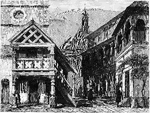
Town of Oberkirch
Oberkirch is a manufacturing town in Western Baden-Württemberg, Germany about 12 km North-East…
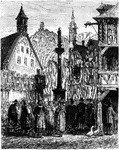
Simonswald
Archaeological artifacts show that Simonswald was home to farmers as early as 6000 to 3000 BC. Roman…
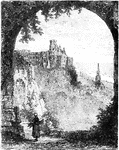
Heidelberg Castle Viewed from Terrace
View of the castle framed by an arch. A landmark of Heidelberg, the castle ruins are among the most…
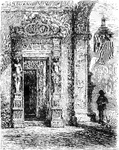
Interior of Heidelberg Castle
Interior view of Heidelberg Castle with elaborately carved doorway and part of a courtyard.
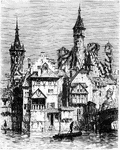
Castle of Unnoth
The Castle of Munnoth, sometimes called Unnoth, was erected in 1564, is a singular specimen of fortification…
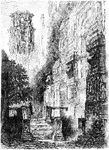
Entrance to Heidelberg Castle
A landmark of Heidelberg, the castle ruins are among the most important Renaissance structures north…
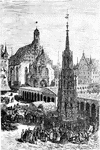
Nuremberg
A market place in Nuremberg. Nuremberg, a city of the Middle Ages, is filled with works of art of the…

Choir of the Church of St. Sebald
A church of both Roman and Gothic architectural design. From the wall of the presbytery and extending…
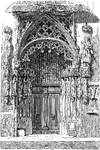
Bride's Door at Church of St. Sebald
St. Sebald is a church of both Roman and Gothic architectural design. On the northern side is the Bride's…
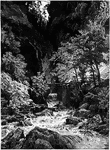
Wimbach Ravine
The Wimbach ravine resides at the entrance of the Wimbach valley, one of the 3 main valleys of the national…

Exterior of Walhalla
Walhalla, or German Temple of Fame and Honor is a neo-classical hall of fame located on the Danube River…
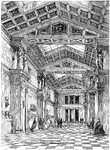
Interior of Walhalla
Walhalla, or German Temple of Fame and Honor is a neo-classical hall of fame located on the Danube River…

Glyptothek
The Glyptothek is a museum in Munich, Germany, which was commissioned by the Bavarian King Ludwig I…

Pinacothek
The Alte Pinakothek (Old Pinakothek) is an art museum situated in the Kunstareal in Munich, Germany.…
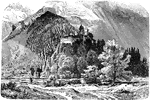
Castle of Hohenaschau
Schloss Hohenaschau, is the dominating feature in the town of Aschau im Chiemgau in Bavaria. The huge…

Falkenstein Castle
Falkenstein Castle or Castrum Pfronten is a High Middle Ages castle ruin in the Bavarian Alps, near…

Hotel De Ville
Hotel De Ville was constructed about 1370 in the second half of the fourteenth century. Frescos at one…

City, Passau
Passau is one of the oldest cities in Germany, a village of Gauls in early days; and later, a Roman…

Big Strudel
The principal meaning of the German word strudel is whirlpool. Big Strudel, the vortex near Grein, 94…
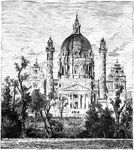
Church at St. Charles Borromeo, Vienna
The Karlskirche (German for St. Charles's Church) is a church situated on the south side of Karlsplatz,…
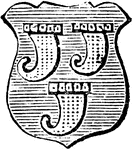
Clarion
"Azure, three clarions or. CLARION. A horn or trumpet borne in this shape in English and German coat-armour."…

Emperor Maximilian
This is an engraving was created by Albrecht Dürer, of the Emperor Maximilian. He formed the first…
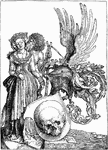
The Arms of Death
The Arms of Death is an engraving that was created by German artist Albrecht Dürer in 1503. It…
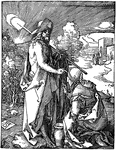
Christ Appearing to St. Magdalene
Christ Appearing to St. Magdalene is a woodcut that is part of a series called "Little Passion" by German…
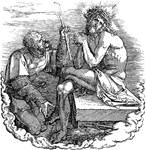
The Man of Sorrows
The Man of Sorrows is a woodcut by German artist Albrecht Dürer. It is part of a series called…
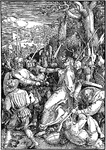
Christ Taken Prisoner
Christ Taken Prisoner is a woodcut by German artist Albrecht Dürer in 1510. It is part of a series…
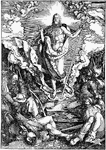
The Resurrection
The Resurrection is a woodcut by German artist Albrecht Dürer in 1510. It is part of a series called…
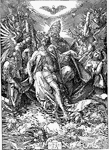
The Holy Trinity
The Holy Trinity is a woodcut that was created by German artist Albrecht Dürer in 1511. This woodcut…
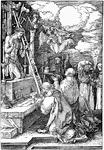
The Mass of St. Gregory
The Mass of St. Gregory is a woodcut that was created by German artist Albrecht Dürer in 1511.…

Christ Before Caiaphas
Christ Before Caiaphas is an engraving that was created by German artist Albrecht Dürer. It is…

The Entombment
The Entombment is an engraving created by German artist Albrecht Dürer in 1512. It is part of a series…
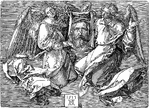
Two Angels with St. Veronica's Napkin
Two Angels with St. Veronica's Napkin is an engraving that was created by German artist Albrecht Dürer…
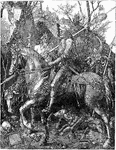
The Knight, Death and the Devil
The Knight, Death and the Devil is an engraving that was created by German artist Albrecht Dürer…
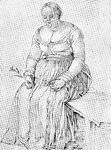
Pen-Drawing From Life
The Pen Drawing From Life probably was created by German artist Albrecht Dürer in 1514. It probably…
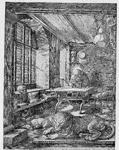
St. Jerome In His Cell
St. Jerome in his Cell is an engraving that was created by German artist Albrecht Dürer in 1514.…
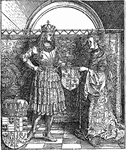
The Emperor Maximilian and his Bride, Mary of Burgundy
The Emperor Maximilian and his Bride, Mary of Burgundy is a woodcut that was created by German artist…
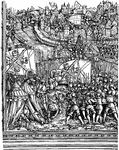
Troops Entering a Town After a Siege
Troops Entering a Town After a Siege is a woodcut that was created by German artist Albrecht Dürer.…
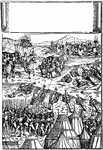
The Emperor Maximilian Receiving the Submission of a Besieged City
The Emperor Maximilian Receiving the Submission of a Besieged City is a woodcut that was created by…

The Investiture of the Duke of Milan
The Investiture of the Duke of Milan is a woodcut that was created by German artist Albrecht Dürer.…
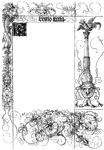
A Page from the Emperor Maximilian's Prayer Book
This is a Page from the Emperor Maximilian's Prayer-Book. The drawings in the margins where created…
Margin Drawing
This margin drawing was created by German artist Albrecht Dürer in 1515. It is found in the prayer…

Margin Drawing
This margin drawing was created by German artist Albrecht Dürer in 1515. It is found in the prayer…
Margin Drawing
This margin drawing was created by German artist Albrecht Dürer in 1515. It is found in the prayer…

Margin Drawing
This margin drawing was created by German artist Albrecht Dürer in 1515. It is found in the prayer…
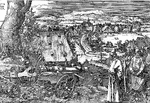
The Great Cannon
The Great Cannon is an etching that was created by German artist Albrecht Dürer in 1518. It depicts…
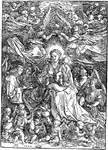
The Virgin and Child Surrounded by Angels
The Virgin and Child Surrounded by Angels is a woodcut that was created by German artist Albrecht Dürer…
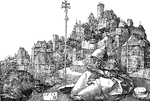
St. Anthony
This is an engraving of St. Anthony by German artist Albrecht Dürer in 1519. It shows a view of a view…
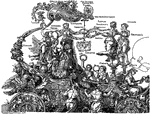
The Emperor Maximilian on the Triumphal Car
The Emperor Maximilian on the Triumphal Car is a woodcut that was created by German Artist Albrecht…
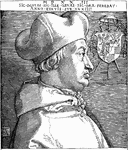
Cardinal Albrecht of Brandenburg
This is an engraved portrait of Cardinal Albrecht of Brandenburg, Germany. He was a cardinal priest…
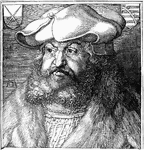
Elector Frederick the Wise
This is an engraved portrait of Elector Frederick the Wise who was Elector of Saxony, Germany. It was…

Wilibald Pirkheimer
This is an engraved portrait of Wilibald Pirkheimer a wealthy prominent figure in Nuremburg, Germany.…
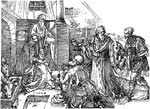
Adoration of the Magi
The Adoration of the Magi is a pen-drawing that was created by German artist Albrecht Dürer in…
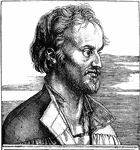
Philip Melanchthon
This is an engraved portrait of Philip Melanchthon who was a German Professor and Theologian. He was…
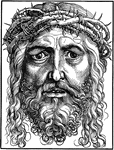
Large Head of Christ
The Large Head of Christ is a chiaroscuro (contrast between light and dark) woodcut that was created…

The Coat of Arms with the Cock
This engraving of the Coat of Arms with the Cock was created by German artist Albrecht Dürer. It…

Albrecht Dürer's Pirkheinmer Border
Albrecht Dürer's Pirkheimer Border is a woodcut that was created by German artist Albrecht Dürer…
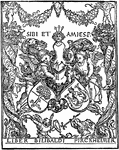
Pirkheimer's Bookplate
Pirkheimer's bookplate is a woodcut that was created by German artist Albrecht Dürer. It includes…
